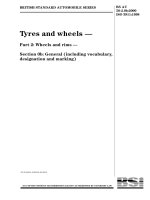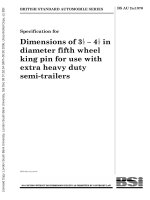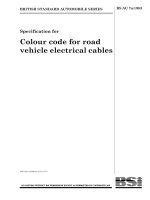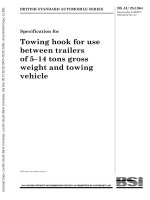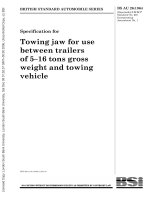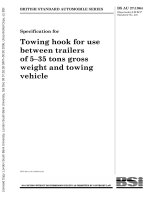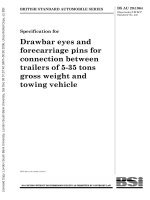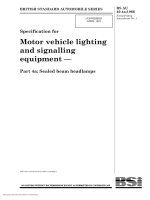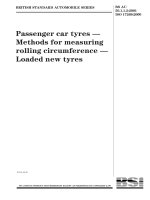Bsi bs au 150b 1984 (2000)
Bạn đang xem bản rút gọn của tài liệu. Xem và tải ngay bản đầy đủ của tài liệu tại đây (763.87 KB, 26 trang )
BRITISH STANDARD AUTOMOBILE SERIES
BS AU
1 5 0b:1 984
(Superseding the first
revision (1 973) of
BS AU 150)
Specification for
Automotive V-belts and
pulleys
UD C 62 9 . 1 1 3 . 0 1 : 62 1 . 85 . 0 5 2 . 42
BS AU 150b:1984
Committees responsible for this
British Standard
The preparation of this British Standard was entrusted by the Mechanical
Engineering Standards Committee (MEE/- ) and the Automobile Standards
Committee (AUE/- ) to Technical Committee MEE/76 upon which the following
bodies were represented:
Agricultural Engineers’ Association
British Gear Manufacturers’ Association
British Rubber Manufacturers’ Association
National Coal Board
Society of Motor Manufacturers and Traders Limited
Coopted members
This British Standard, having
been prepared under the
direction of the Automobile
Standards Committee and
the Mechanical Engineering
Standards Committee, was
published under the authority
of the Board of BSI and comes
into effect on
30 April 1 984
© BSI 02- 2000
Amendments issued since publication
First published 1 966
First revision July 1 973
Second revision April 1 984
The following BSI references
relate to the work on this
standard:
Committee reference MEE/76
Draft for comment 81 /80008 DC
ISBN 0 580 13834 8
Amd. No.
Date of issue
Comments
BS AU 150b:1984
Contents
Page
Committees responsib le
Inside front cover
Foreword
iii
Section 1 . General
1.1
Scope
1
1.2
D efinitions
1
Section 2 . Belts
2. 1
D esignation
2
2. 2
C ross section dimensions
2
2. 3
E ffective length
2
2. 4
Tolerances on nominal belt length
3
2. 5
Matched set tolerance
3
2. 6
Variation of belt cross section
3
2. 7
Variation of b elt ride- out
3
2. 8
Mean value of ride- out
3
4
2. 9
Belt test life
2. 1 0
E lectrical resistance
4
2. 1 1
Resistance to ozone
5
2. 1 2
Resistance to oil
5
2. 1 3
Hardness of rubb er core
5
2. 1 4
Resistance to low temperature
5
2. 1 5
Resistance to high temperature
5
2. 1 6
Marking
5
Section 3. Pulleys
3. 1
D esign and construction
5
3. 2
D imensions
5
3. 3
D esignation
5
3. 4
Surface of grooves
7
3. 5
C ast iron pulleys
7
3. 6
Axial and radial run- out
7
Appendix A Information to be supplied b y the purchaser
8
Appendix B Recommended nominal belt lengths
8
Appendix C D etermination of b elt test life
9
Appendix D D etermination of electrical resistance of belts
12
Appendix E D etermination of b elt resistance to ozone
13
Appendix F D etermination of belt resistance to oil
13
Appendix G D etermination of belt resistance to low temperature
14
Appendix H D etermination of b elt resistance to high temperature
14
Appendix J Measurement of run- out of pulleys
14
Appendix K Guidance and calculations for drive design
14
Figure 1 — E ffective line differential
3
Figure 3 — Groove cross section of measuring fixture pulley
4
Figure 4 — Mean value
f of b elt
ride- out on measuring pulley
Figure 5 — Belt cross section
Figure 6 — Groove cross section of production pulley
© BSI 02 - 2 000
2
Figure 2 — Layout of measuring fixture
4
5
6
Figure 7 — Layout of test machine
11
Figure 8 — Apparatus for measuring the electrical resistance of belts
13
Figure 9 — Arrangement for radial run- out measurement
14
i
BS AU 150b:1984
Page
Figure 1 0 — Arrangement for axial run- out measurement
14
Figure 1 1 — Layout of drive
16
Tab le 1 — Nominal dimensions of b elt cross section
Tab le 2 — D imensions and characteristics of measuring fixture pulleys
3
Tab le 3 — Belt measuring force
3
Tab le 4 — D imensions and characteristics of pulleys
6
Table 5 — Recommended nominal b elt lengths for AV 1 0 groove section
8
Table 6 — Recommended nominal b elt lengths for AV 1 3 groove section
9
Tab le 7 — D imensions and characteristics of test pulleys
10
Table 8 — Sequence of calculation
15
Tab le 9 — Service factors for driven auxiliaries
17
Tab le 1 0 — Arc of contact factor
K
1
Tab le 1 1 — Centrifugal tension factor
Publications referred to
ii
3
K
2
17
17
Inside back cover
© BSI 02 - 2 000
BS AU 1 5 0 b : 1 984
Fore word
This revision of this British Standard was prepared under the direction of the
Automobile Standards Committee and the Mechanical Engineering Standards
Committee. The obj ect is to provide standard dimensions, quality control test
procedures and design data for automotive V- belts and their corresponding
pulleys, based on practical experience of both manufacturers and users. This
revision supersedes the 1 973 edition which is withdrawn.
In this standard requirements for the pulley groove profile are specified but
requirements for the fit of the belt in the groove are only specified for the purposes
of length measurement and accurate speed ratio determination. Nominal
dimensions of belts are specified solely for information for users and no
requirements are given for belt performance.
This standard is technically equivalent to ISO 2790: 1 974 and ISO 5287: 1 978,
published by the International Organization for Standardization (ISO), but,
whereas ISO 2790 uses the “pitch” width of the belt system this standard uses the
“effective width” of the pulley system.
A British Standard does not purport to include all the necessary provisions of a
contract. Users of British Standards are responsible for their correct application.
C o mp liance with a British S tandard doe s not o f itse lf confe r immunity
fro m le gal ob ligations.
S ummary o f p age s
This document comprises a front cover, an inside front cover, pages i to iv,
pages 1 to 1 8, an inside back cover and a back cover.
This standard has been updated (see copyright date) and may have had
amendments incorporated. This will be indicated in the amendment table on the
inside front cover.
© BSI 02- 2000
iii
iv
blank
BS AU 1 5 0 b: 1 984
Section 1 . General
NOTE 2
The effective line differential is used to obtain pitch
diameters from the effective diameters and hence calculate the
speed ratio.
1 . 1 S cope
1 .2.7
This British Standard specifies the nominal cross
section dimensions for V- belts and the design and
construction of the corresponding pulleys used for
driving the auxiliaries of automotive power units
and their derivatives.
V-b e lt
an endless flexible belt having a cross section that
approximates to a regular trapezium. On a cross
section of a straight sided belt, the trapezium is
outlined by the base, sides and top of the belt. The
Recommended nominal belt lengths are given in
intersection of the extended profiles of the base,
Appendix B. Appendix K gives guidance on the
sides and top occurs when the corners are cut short
calculations for drive design.
or rounded
This standard does not specify requirements for belt
performance.
NOTE
1 .2.8
V-b e lt drive
The titles of the publications referred to in this standard
are listed on the inside back cover.
a drive comprising one or more belts mounted on
V- grooved pulleys. The profiles of the belts and the
pulley grooves are such that the belts only come into
1 . 2 D efinitions
For the purposes of this British Standard the
following definitions apply.
contact with the sides of the pulley grooves and not
with the base of the grooves
1 .2.9
1 .2.1
spe e d ratio
V-groove d p ulle y
a pulley with one or more grooves around the
circumference. The grooves have profiles of a
truncated, non- truncated or rounded “V” that is
symmetrical to the pulley axis
the ratio of the number of revolutions of the pulleys,
calculated from the ratio of the pitch diameters of
the pulleys
1 .2.1 0
top width,
1 .2.2
e ffe ctive width,
W
W
the larger width of the trapezium outlined on a cross
e
a groove width dimension characterizing the groove
section (see Figure 5)
profile. It is a defined value not subj ect to tolerance
1 .2.1 1
(see Figure 1 )
he ight,
NOTE
the height of the trapezium outlined on a cross
For all belt measuring pulleys, the effective width
coincides with the actual top width of the groove within the
specified tolerances.
e ffe ctive diame ter,
d
e
the diameter of the pulley at the effective width of
the pulley groove (see Figure 3 and Figure 6)
angle ,
A
the included angle obtained by extending the side of
the belt (see Figure 5)
1 .2.1 3
1 .2.4
pitch diameter
the effective diameter corrected for the effective line
differential
NOTE
section (see Figure 5)
1 .2.1 2
1 .2.3
T
This calculation makes no allowance for slip and creep.
effective length,
L
e
the length of a line circumscribing a belt at the
effective diameter of the measuring pulleys
1 .2.1 4
ride -out
1 .2.5
pitch width,
W
p
the width of the belt at its neutral axis (see Figure 1 )
the distance from the top of the belt to the effective
width level of the pulley
1 .2.1 5
1 .2.6
groove angle ,
effe ctive line diffe rential
the radial displacement between the levels of the
effective width of the pulley and the pitch width of
the belt (see Figure 1 )
NOTE
a
the included angle obtained by extending the sides
of the pulley grooves (see Figure 3 and Figure 6)
NOTE
For any given belt section the pulley groove angle will
have a value dependent on the effective diameter of the pulley.
When the effective line differential is zero, the pitch
width of the belt and the effective width of the pulley are
coincident.
© BSI 02- 2000
1
BS AU 1 5 0 b :1 984
2 . 3 . 2 Method of me asure me nt
1 .2.1 6
effe ctive circumfe rence ,
C
e
2.3.2.1
Measuring fixture.
The measuring fixture
the circumference of a circle with a diameter equal
shall consist of two pulleys with dimensions as
to the effective diameter
shown in Table 2 and layout as shown in Figure 2,
with a groove section as shown in Figure 3, and with
one pulley centre fixed. The other pulley shall be
Section 2 . Belts
moveable in a plane at right angles to the axes of the
pulleys and in a line with the grooves of the pulleys.
2 . 1 D esignation
Belts shall be designated by the groove profile in
which they are intended to be run as AV 1 0 or AV 1 3
and by their nominal effective length.
The pulleys shall be fully rotatable and a means of
applying a measuring force shall be provided.
2.3.2.2
Pro cedure.
Mount the belt on the measuring
fixture (2 . 3 . 2 . 1 ) and position in the grooves under
2 . 2 C ross section dimensions
The nominal cross section dimensions and the
nominal included angle shall be as given in Table 1 .
2 . 3 . 1 General.
NOTE
any measurements, so that the measuring force
F
is
equally divided between the two strands of the belt.
Determine the effective length
2 . 3 E ffective length
L
e
(in mm) of the belt
from the following equation:
The effective length shall be
measured in accordance with
the forces given in Table 3. Rotate the pulleys at
least twice to seat the belt properly, before making
2.3.2.
No requirements are specified for effective length: these
should be specified by the purchaser [see Appendix A a) ] .
L
e
= 2C +
C
e
where
C
is the centre distance of the measuring
pulleys (see Figure 2) (in mm) ;
C
e
is the effective circumference of one
measuring pulley (see Table 2) (in mm) .
Figure 1 — E ffe ctive line differe ntial
2
© BSI 02- 2000
BS AU 1 50b:1 984
Table 1 — Nominal dimensions of belt cross section
Belt designation
Top width
AV 10
AV 13
10
13
W
Height
mm
8
10
T
mm
Included angle
A
mm
40
40
NOTE The nominal cross section dimensions are in accordance with those
given in ISO 2790.
NOTE This figure is diagrammatic only.
Figure 2 — Layout of measuring fixture
Table 2 — Dimensions and characteristics of measuring fixture pulleys
Belt
designation
AV 10
AV 13
Diameter of
Distance between
Effective
Effective
Effective
Groove
Groove
balls/rollers for
external tangent
width
diameter
circumference
angle
depth
checking pulley
plane of
groove
balls/rollers
We
mm
9.7
12.7
De
mm
95.5 ± 0.2 300
95.5 ± 0.2 300
a
Ce
mm
AV 10
AV 13
Measuring force
F
270
270
N
2.4 Tolerances on nominal belt length
The tolerance on nominal belt length shall
be ± 0.6 % or ± 6 mm, whichever is the greater.
NOTE Appendix B gives a range of recommended nominal belt
lengths.
2.5 Matched set tolerance
mm
36 ± 0.2 11.0
36 ± 0.2 13.5
Table 3 — Belt measuring force
Belt designation
degrees
p
d
mm
9 ± 0.01
12 ± 0.01
Ke
mm
103.77 ± 0.05
107.25 ± 0.05
2.6 Variation of belt cross section
The variation of the belt cross section shall be such
that, when the belt is rotated slowly for at least one
complete revolution of length on the measuring
fixture described in 2.3.2.1 , the pulley centre
distance shall not vary by more than 1.0 mm.
2.7 Variation of belt ride-out
Except for variations due to fabric splices or brand
identifications, the variation in the belt ride-out
shall be not more than 1.0 mm when the belt is
rotated slowly for at least one complete revolution of
length on the measuring fixture described
in 2.3.2.1 .
NOTE Variations due to fabric splices or brand identifications
In order to avoid an uneven distribution of load,
should be ignored.
belts used on a multi-belt drive shall be length
matched. The maximum variation in length within 2.8 Mean value of ride-out
a matched set shall be 0.2 % or 2 mm, whichever is The mean value f of the ride-out (see Figure 4) for
the greater.
the belts given in Table 5 and Table 6 shall not
exceed 1.6 ± 0.8 mm.
© BSI 02-2000
3
BS AU 1 5 0b:1 984
Figure 3 — Groove cross section of measuring fixture pulley
2.9 Belt test life
Belt test life shall be determined in accordance with
Appendix C.
NOTE
Appendix C determines the belt test life only. No
requirements are specified for service behaviour and life: this
should be specified by the purchaser [see Appendix A b) ] .
2.1 0 Electrical resistance
For new, complete, endless and anti- static belts the
electrical resistance (in
7), when determined in
accordance with Appendix D, shall be not greater
than the following:
L × 10
0. 6
--------------
I
6
where
L
Figure 4 — Mean value
f of belt ride-out on
measuring pulley
I
T
A
NOTE
is the dry distance between electrodes
(in mm);
is the sum of the lengths of the two sloping
sides of the belt (in mm) = 2
T sec (A/2)
is the height;
is the included angle (see Figure 5).
For general information on electrical resistance of
conductive and anti- static products made from flexible polymeric
material see BS 2050.
4
© BSI 02- 2000
BS AU 1 50b:1 984
NOTE
It is recommended that the following system be used for
the marking of belts:
Groove section designation
Effective length
AV 1 0
1 250
Section 3. Pulleys
NOTE
No requirements are specified for balancing of pulleys
which should not generally be necessary. However, it is
considered necessary in certain cases, e. g. for relatively massive
cast iron pulleys, cast unmachined pulleys and for pulleys
running at high speed. In these cases balancing of pulleys should
be specified by the purchaser [see Appendix A f) ] .
3.1 Design and construction
Pulleys shall be designed and constructed so as to
meet the requirements for service behaviour and life
as specified by the purchaser [see Appendix A b)] .
Figure 5 — Belt cross section
2.1 1 Resistance to ozone
When tested in accordance with Appendix E the belt
shall show no sign of cracking, separation or any
other deterioration likely to impair service
behaviour and life.
NOTE
No requirements are specified for service behaviour and
life: this should be specified by the purchaser [see Appendix A b) ] .
2.1 2 Resistance to oil
Stiffness shall be such that no significant deflection
of the pulley groove sides occurs under normal
operating conditions.
NOTE
The tensile strength of the material should be sufficient
to withstand the centrifugal stress to be imposed in service
behaviour and life [see Appendix A b) ] .
3.2 Dimensions
NOTE
No requirements are specified for the effective diameter
of pulleys as this depends on the belt construction to be used and
should be supplied by the manufacturer. However, Table 4 gives
recommended values.
3.2.1 Pulley grooves. When measured either
Resistance to oil shall be determined in accordance
directly or with balls or rollers the dimensions of
with Appendix F.
pulley grooves shall be as given in Table 4 and as
NOTE
shown in Figure 6.
No requirements are specified for resistance to oil: this
should be specified by the purchaser [see Appendix A d) ] .
2.1 3 Hardness of rubber core
NOTE
Additional data for measurement by balls or rollers is
given in Table 4 and Figure 6.
3.2.2 Multi-grooved machined pulleys for use
Hardness of the rubber core shall be determined in
with matched belt sets. When gauge balls or
accordance with BS 903- A26.
rollers are used, the effective diameter
NOTE
(see Table 4) shall not vary from groove to groove by
No requirements are specified for hardness: this should
be specified by the purchaser [see Appendix A e) ] .
2.1 4 Resistance to low temperature
de
+ 2 Xe
more than 0. 05 mm per 25 mm of the effective
diameter with an upper limit of 0. 30 mm.
When tested in accordance with Appendix G the belt
3.3 Designation
shall be free from cracks or other visible defects that
Pulleys shall be designated by the following:
would impair service behaviour and life
[see Appendix A b)] .
2.1 5 Resistance to high temperature
When tested in accordance with Appendix H the belt
shall be free from cracks or other visible defects that
would impair service behaviour and life
[see Appendix A b)] .
2.1 6 Marking
Belts shall be marked legibly and durably on the
a) the effective diameter (in mm);
b) the number of grooves;
c) the groove profile (AV 1 0 or AV 1 3) .
Example:
56
×
1 AV 1 0
In the case of integral pulleys with different grooves,
successive designation of the elements shall
be used, e. g. :
70
×
1 AV 1 3, 56
×
1 AV 1 0.
outer non- working surface with the belt designation
specified in 2.1 or the purchaser’s part number.
© BSI 02- 2000
5
BS AU 1 5 0 b :1 984
Tab le 4 — D ime nsions and characte ristics of p ulle ys
Pulle y
de signation
E ffe ctive
W
width
Groove angle re late d to
da
e ffe ctive diame te r
e
mm
e
Groove
C e ntre to
d e p th
ce ntre of
D iame te r o f
b e low
groove s,
me asuring
effe ctive
minimum
b alls/rolle rs
line
distance
p
3 4°
36°
38°
mm
mm
mm
mm
e
mm
D istance fro m e ffe ctive
diame te r to the e xte rnal
tange nt of b alls/rolle rs, at
X
d
mm
groove angle
e
34°
3 6°
mm
mm
9.0 ± 0.01 4.03
4.14
± 0.08
± 0.08
3 8°
mm
4.24
± 0.08
AV 10
9.7
56 to 70 70 to 180 180 11.0
min.
12.0 + 0.3
– 0.0
AV 13
12.7
70 to 90 80 to 180 180 13.5
min.
5.87
5.99
15.0 + 0.3 12.0 ± 0.01 5.75
– 0.0
± 0.08
± 0.08
± 0.08
a The
effective diameter for a particular section is dependent on the belt construction used. The purchaser should request the
manufacturer to supply this information. The values given are recommended values. If different angles of a pulley are required, the
groove flanks should hinge about the effective line.
Figure 6 — Groove cross section of p roduction pulley
6
© BSI 02-2000
BS AU 1 50b:1 984
3.4 Surface of grooves
The s urface finis h of grooves s hall b e not more
than 3 . 2
4
m
R
a
when determined b y the method
3.6 Axial and radial run-out
When meas ured in accordance with Ap p endix J the
axial run- out of a machined p ulley on its shaft s hall
des crib ed in BS 1 1 3 4- 1 . The groove surface of s teel
not exceed 0. 00 2 mm p er millimetre of p ulley
p ulleys s hall have a hardnes s of not les s
diameter or 0. 3 mm, whichever is the greater.
than 1 3 0 H B when tested in accordance with
BS 2 40- 1 .
3.5 Cast iron pulleys
C ast iron used for p ulleys shall b e clos e- grained and
free from p oros ity. Machined p ulleys s hall have no
b lowholes in the groove.
© BS I 0 2 - 2 00 0
The axial run- out of a p res sed, s p lit or unmachined
p ulley on its shaft shall not exceed 0. 3 mm.
When meas ured in accordance with Ap p endix J the
radial run- out of the p ulley on its s haft s hall not
exceed 0. 3 mm.
The diameter of the b alls or rollers used shall b e not
less than thos e given in Tab le 2 .
7
BS AU 1 5 0 b : 1 984
Ap p e ndix A Information to b e
App e ndix B Recomme nde d nominal
sup p lied b y the p urchaser
b e lt le ngths
The following particulars cover essential details to
Tab le 5 — Re co mme nde d nominal b e lt le ngths
be given to the belt manufacturer by a purchaser so
that an enquiry or order may be fully understood:
a) effective belt length required (see
for AV 1 0 groo ve se ction
E ffe cti ve le ngth
E ffe ctive le ngth
2 . 3 . 1 );
Pre ferre d
No n p re fe rre d
Pre fe rre d
mm
mm
mm
No n p re fe rre d
b) service behaviour and life and requirements
for belt test life (see
2 . 9 );
c) whether the belt is to be marked with the
purchaser’s part number (see
2 . 1 6 );
d) allowance for percentage change in volume for
determination of resistance to oil (see
2 . 1 2 );
e) hardness required by the purchaser (see
2 . 1 3 );
f) whether pulleys are required to be balanced
g) dimensioned drawing of the application, power
1 075
638
1 1 00
1 088
1 113
650
663
1 1 25
688
1 1 50
71 3
1 1 75
738
1 200
1 1 38
675
1 1 63
700
requirements, speeds and adj ustable take- ups
required for the belt (see Appendix K) .
61 3
625
(see note to section 3);
1 1 88
725
1 21 3
750
763
1 225
788
1 250
81 3
1 275
838
1 300
1 238
775
1 263
800
1 288
825
1 31 3
850
863
1 325
888
1 350
91 3
1 375
938
1 400
1 338
875
1 363
900
1 388
925
1 41 3
950
963
1 425
988
1 450
1 01 3
1 475
1 038
1 500
1 438
975
1 463
1 000
1 488
1 025
1 050
8
mm
1 063
600
1 51 3
© BSI 02- 2000
BS AU 1 5 0 b : 1 984
Tab le 6 — Re comme nd e d no minal b e lt le ngths
for AV 1 3 groo ve se ction
E ffe ctive le ngth
Ap p endix C D e te rmination of b e lt te st
life
E ffe cti ve le ngth
C . 1 Introduction
Pre ferre d
No n p re fe rre d
Pre fe rre d
No n p re fe rre d
mm
mm
mm
mm
775
788
800
813
825
838
850
863
875
888
900
913
925
938
950
963
975
1 000
1 025
1 050
1 075
1 100
1 125
1 150
1 175
1 200
1 225
1 250
1 275
988
1 013
1 038
1 063
1 088
1 113
1 138
1 163
1 188
1 213
1 238
1 263
1 288
© BSI 02-2000
1 300
1 325
1 350
1 375
1 400
1 425
1 450
1 475
1 500
1 525
1 550
1 575
1 600
1 625
1 650
1 675
1 700
1 725
1 750
1 775
1 800
1 313
1 338
1 363
1 388
1 413
1 438
1 463
1 488
1 513
1 538
1 563
1 588
1 613
1 638
1 663
1 688
1 713
1 738
1 763
1 788
This test determines belt test life for the purpose of
quality control product verification and comparative
testing. It is generally in accordance with the test
given in ISO 5287.
Since the introduction of V-type belts on automotive
drives, automotive engine and belt manufacturers
have employed laboratory and field tests for product
development, source approval and quality
verification. It is generally agreed that the test
given in ISO 5287 and in this appendix is the best
that has been developed, but this does not imply
that other testing, such as field testing, should be
circumvented.
C . 2 Princip le
To determine the belt test life in hours by fatigue
testing under specified conditions on a three-pulley
test machine.
C . 3 Ap p aratus
as shown
diagrammatically in Figure 7, consisting of the
following.
a) A driving pulley and suitable driving unit.
b) A driven pulley to which a suitable absorption
unit is connected.
c) An idler pulley and arrangement through
which tension can be supplied to the belt.
d) A means of determining belt slip to an accuracy
of ± 1 %.
C . 3 . 1 Dynam ic three- p ulley test m achine,
NOTE This can be determined, for example, by electronic
digital counting or by calibrating the instrument used for
measuring belt slip and checking periodically by electronic
digital counting.
The test machine shall be of such a robust design
that it will meet the following requirements.
1) The general layout of the pulleys relative to
each other shall be as shown in Figure 7. A belt
shall be run-in for 2 min under dead-weight
conditions and dial indicators shall then be
positioned, as shown in Figure 7, on the pulley
flange furthest away from the bearing in each
case.
2) For AV 10 belts a tension of 490 N shall be
applied at the idler pulley and a tension of 590 N
for AV 13 belts. The minimum idler pulley
diameter (see note 2 to Table 7) and the
corresponding groove angle (see Table 7) shall be
used for the respective cross sections.
3) The maximum deflection for each pulley
irrespective of belt section used shall be 0.25 mm.
9
BS AU 1 5 0 b : 1 984
4) The power absorption unit shall be capable of
maintaining the test load to within ± 0.1 kW for
the duration of the test and shall be capable of
calibration, e.g. by dead weights. In order that
tension can be satisfactorily applied to the belt
and so as to allow for belt stretch the idler pulley
and its bearing assembly shall be free to slide, as
and when necessary, in its support bracket along
the line of application of the tensioning force, as
shown in Figure 7.
5) In order to accommodate different lengths of
belts, the relevant driving pulley and/or the
relevant driven pulley and the position of the
idler pulley and/or its support bracket shall be
adjustable so that the test layout of the three
pulleys is attainable for each belt length.
6) The line of action of the tensioning force shall
bisect the belt layout angle at the idler pulley
(see Figure 7), shall pass through the axis centre
of the idler pulley and shall lie in the plane
through the centre of the groove of the idler
pulley.
The pulleys shall be made from a
direct-hardening steel equivalent to steel 708M40,
as specified in BS 970-1, and the pulley groove shall
have a surface condition such that the surface
condition shall not vary by more than 0.8 4m a,
when determined in accordance with BS 1134-1.
C.3.2
Test p ulleys.
R
NOTE For appropriate dimensions and characteristics for belts
and pulleys see Table 1 and Table 7 respectively.
C . 4 Te st conditions
For each test, the general
layout of the pulleys relative to each other shall be
as shown in Figure 7, the centre distance (in mm)
between the driving and driven pulleys being
within ± 2 mm of the value determined by the
following equation:
2.414 = – 0.785 (3 + ) – ( – )
where
is the centre distance between the driving and
driven pulleys (in mm);
is the effective length of the belt measured in
accordance with
(in mm);
is the diameter of both the driving and driven
pulleys (in mm);
is the diameter of the idler pulley (in mm).
The test speed, i.e. the rotational
speed of the driving pulley, shall
be 4 900 r/min ± 2 % for AV 10 belts
and 4 700 r/min ± 2 % for AV 13 belts.
The test load (in N) applied to the
idler pulley shall be such that
=
where
is the test load (in N);
= 60 N/kW;
is the transmitted power (in kW).
C.4.2
Layout o f p ulleys.
C
L
D
d
D
d
C
L
2.3.2
D
d
C.4.3
Test sp eed.
C.4.4
Tes t load.
N
Kx
N
K
x
NOTE The recommended power for this test is 8.2 kW
for AV 10 belts and 10.0 kW for AV 13 belts.
The ambient temperature of the
test house shall be between 18 °C and 32 °C and the
mean ambient temperature for the duration of the
test shall be given with the result of the test. The
atmosphere in the vicinity of the test drive shall be
free of draughts resulting from sources other than
the test machine itself.
C.4.1
Test hous e.
Tab le 7 — D ime nsions and characte ristics o f te st p ulle ys
Pu lle y
d e signatio n
E ffe cti ve
Gro o ve angle o f
E ffe ctive
Gro o ve
E ffe cti ve
Mi ni mu m
Mi ni mu m
d i ame te r o f
d ri ving/d ri ve n
di ame te r o f
angle o f
wi d th o f
gro o ve
cu rve rad i u s
d ri vi ng/d rive n
p u lle ys
i d le r p ulle y
i d le r p u lle y
p ulle y
d e p th
o f sid e s at to p
p u lle ys
D
e
mm
µ
degrees
AV 10
121 ± 0.2
36 ± 0.5
AV 13
127 ± 0.2
36 ± 0.5
e
o f gro o ve
gro o ve W
d
e
mm
56
63 ± 0.5
76
70
76 ± 0.2
89
a
degrees
34
34 ± 0.5
36
34
34 ± 0.5
34
mm
p
R
mm
mm
9.7
11.0
0.8
12.7
13.75
0.8
NOTE 1 These dimensions and characteristics are appropriate for the sizes of belts given in Table 1.
NOTE 2 The diameter of the idler pulley should be agreed between the manufacturer and the purchaser and will be dependent
upon the conditions of use envisaged for the belt.
10
© BSI 02-2000
BS AU 1 5 0 b : 1 984
Turn the drive manually for several revolutions of
C . 5 Proce dure
C.5.1
Prep aration.
After mounting the belt on the
pulleys, apply the test load (C . 4 . 4 ) to the belt and,
the belt and note the maximum limits of travel of
the idler pulley on the dial indicator.
leaving the idler pulley support bracket free to move
Immediately lock the idler pulley support bracket in
in its slide, bring the drive up to the test
the position midway between the two limits of
speed (C . 4 . 3 ) and apply the test load to the driven
travel.
pulley as quickly as possible. Run the drive under
these conditions for 5 min ± 1 5 s, not including
starting and stopping time. Stop the machine and
leave it to stand for 1 0 min.
NOTE 1
45 ° is recommended for the initial test layout and this may change slightly with re- tensioning during the course of the
test.
NOTE 2
It is essential that the misalignment of the belt, when mounted on the test machine, is not more than ± 0. 25 ° in relation
to the plane through the centre of each pulley groove.
NOTE 3
This figure is diagrammatic only.
Figure 7 — Layout of te st machine
© BSI 02- 2000
11
BS AU 1 5 0 b : 1 984
Restart the machine, bring the drive up
comprising a conducting
to the test speed (
), apply the test load (
) liquid consisting of the following:
to the driven pulley and measure the slip between
the driving and the driven pulleys. Run the drive
a) anhydrous polyethylene glycol of
continuously under these conditions until either the
relative
molecular mass 600
800
belt fails or the additional slip exceeds 4 %, when
b)
water
200
determined as follows:
c) soft soap in accordance with BS 1913
1
o – f × 100
= -------------d) potassium chloride
10
o
preferably made of
where
brass, 25 mm wide, constructed with a V-groove and
with an included angle appropriate to the belt under
p
test. Metal contacts shall be clean (see Figure 8).
o =
q
of B.P. grade.
r
f =
C . 5 . 2 Test.
D . 3 . 2 Liq uid electrodes,
C.4.3
C.4.4
Ratio
g
i
i
g
i
D . 3 . 3 Metal contacts,
N
i
N
D . 3 . 4 Dry fuller’s earth
N
i
D . 3 . 5 Cotton w oo l p ad
s
N
is the initial speed of the driven shaft;
is
the initial speed of the driving shaft;
q
r is the final speed of the driven shaft;
s is the final speed of the driving shaft.
If the additional belt slip
reaches 4 % before belt failure, stop the machine
and let it stand for at least 20 min. Unlock the idler
pulley support bracket, apply the test load to the
belt, turn the drive manually two or three times,
re-lock the idler support bracket and repeat the test
described in
. Repeat this re-tensioning
procedure whenever the additional slip exceeds 4 %
until the belt fails.
Record the number of running hours
under test to belt failure, the number of belt
re-tensions, the diameter of the idler pulley and the
mean ambient temperature during the test.
p
N
N
N
N
C . 5 . 3 Re- tensioning.
C.5.2
C . 5 . 4 Records .
D . 3 . 6 Distilled w ater
D . 4 Me chanical cond itioning
After being strained under the conditions specified
in
, maintain the belt in the unstrained state at
a temperature between 15 °C and 25 °C for a period
of not less than 24 h.
2.3.2
D . 5 Pre p aratio n fo r te st
After mechanical conditioning as described in ,
store the belt for not less than 2 h at a temperature
of 20 ± 2 °C in air with a relative humidity of less
than 70 %.
Clean the surfaces which are to be used in the test
with the dry fuller’s earth (
) using a clean pad
of cotton wool (
) and take care to avoid
straining the belt.
After all traces of powder have been cleaned away,
wipe the surfaces over with a cotton wool pad
moistened with distilled water (
) and rub dry
with a clean cloth.
D.4
D.3.4
D.3.5
D.3.6
Ap p endix D D e termination of
D . 6 Proce d ure
e le ctrical resistance of b elts
D . 6. 1 Prep aration o f liq uid electro des and contacts.
After the preparation of the belt for test in
accordance with , apply the liquid
) to two areas of the belt, each
To determine the electrical resistance of belts using electrodes (
extending 25 mm along the length of the belt, and
an insulation tester under specified limits of
across the full width of the surfaces which make
humidity and temperature.
contact with the pulley groove and located so that
the
dry distance between them is 100 ± 6 mm.
The test shall be carried out on new, complete
Keep
the electrode area completely wet until the end
endless belts.
of the test.
Apply the clean metal contacts (
) to the wetted
having a nominal
areas
of
the
belt
so
that
only
the
driving
surfaces of
open-circuit voltage of 500 d.c. or any suitable
the
belt
are
in
contact.
Apply
a
force
of
1
N/mm to
instrument known to give comparable results. The top width of the belt to press it into the V-groove
to
test instrument shall be sufficiently accurate to
ensure
adequate
electrical
contact
(see
Figure
8).
determine resistance to within 5 % and shall not
dissipate more than 3 W in the belt under test.
D . 1 Princip le
D.5
D.3.2
D . 2 Te st p ie ce s
D . 3 Ap p aratus
D.3.3
D . 3 . 1 Ins ulation tes ter,
12
© BSI 02-2000
BS AU 1 5 0 b : 1 984
Figure 8 — Ap p aratus for me asuring the e le ctrical re sistance of b e lts
Ensure that the surfaces of the belt do not deform
during the application of the contacts or during the
test.
After mechanical conditioning and
preparation, apply the liquid electrodes and metal
contacts, as described in
, to the belt. In no
case shall the voltage applied to the belt be less
than 40 V.
D. 6.2
Tes t.
D.6.1
NOTE Non compliance with the maximum limit of resistance
specification in
can be established only at the specified
upper limits of temperature and humidity (see ). Compliance
can be verified at any permissible testing temperature and
humidity at which the resistance is below the specified limit.
2.1 0
Ap p endix E D e te rmination of b elt
re sistance to oz one
Secure a test piece taken from a belt, without being
masked, around a 50 mm diameter mandrel so that
maximum strain occurs in the outer fibres of the
belt. Age the test piece for 24 h at 20 ± 20°. Expose
the test piece to an ozone concentration
of 0.0025 % / (2 500 p.p.m.) at 38 ± 1 °C for 40 h
in a test cabinet in accordance with BS 903-A43.
V V
D.5
D . 7 Numb e r of te sts
At least five tests shall be made on different areas of
the belt, spaced so that the tests will be
representative of the whole belt. No individual test
result shall be greater than that specified in .
2.1 0
© BSI 02-2000
Ap p e ndix F D e te rmination of b elt
re sistance to oil
Follow the procedure for the volumetric method
described in BS 903-A16 using oil no. 1 for the test
liquid. Immerse the test piece for 72 h at 70 ± 10 °C.
Record the percentage change in volume.
13
BS AU 1 5 0b:1 984
Appendix G Determination of belt
resistance to low temperature
Age a belt in its natural shape for 24 h
at – 30 ± 20 °C. While still at – 30 °C bend the belt
in the same direction as the natural curvature in
stages around a pulley of the same dimensions as
the minimum effective diameter idler pulley given
in Table 7. The belt shall flex easily. Allow the belt
to return to room temperature and flex the same
belt backwards around a 75 mm diameter mandrel.
Appendix H Determination of belt
resistance to high temperature
Age a belt in its natural shape for 70 h
at 100 ± 2 °C. Allow the belt to return to room
temperature and flex the belt backwards around
a 75 mm diameter mandrel.
Appendix J Measurement of run-out of
Figure 1 0 — Arrangement for axial run-out
measurement
Appendix K Guidance and
calculations for drive design
K.1 Arrangement and geometry of drive of
reverse acting idler pulleys
Where practicable, the component having the
smallest
should be located on the slack side of
Measure the axial and radial run-out separately as the drivepulley
to
avoid
concentrating the greatest
the total indicator reading of the movement of a ball bending tension and
the tightside tension a at the
or roller of diameter not less than that given in
same
pulley.
Table 2. Profile mount the indicator arm under
spring pressure to follow the groove as the pulley is It is also desirable to locate the weakest component
on the slack side of the drive. It is essential that
rotated (see Figure 9 and Figure 10).
outside acting idlers should not be located on the
tightside of the drive.
The geometry of the drive should avoid a small arc
of contact of the belt on any heavily loaded pulley.
Elastic mountings should be avoided.
pulleys
T
K.2 Pulley alignment
It is essential to align pulleys accurately so that the
belt is within 0.5° misalignment to prevent groove
jumping if “flutter” occurs on sudden acceleration or
deceleration of down-shifting.
K.3 Sequence of calculation amplified
The sequence of calculation is given in Table 8 and
is further amplified as follows.
a)
Identify pulleys from the layout given
in Figure 11. Pulleys are numbered from crank
and/or driving pulley opposite to the direction of
rotation.
b)
. This is taken from purchaser
information and should be corrected for the
service factor where appropriate (see Table 9).
c)
The effective diameters of
the pulleys may be used for an initial assessment
of speed ratio (within 3 % of the true ratio). For
an accurate assessment of the ratio, the effective
diameter has to be corrected by the effective line
differential (see 1 .2.6).
Pulleys.
Po w er W
Figure 9 — Arrangement for radial run-out
measurement
Pulley diam eter d.
14
© BSI 02-2000
